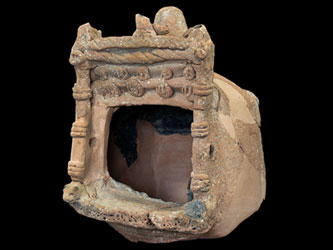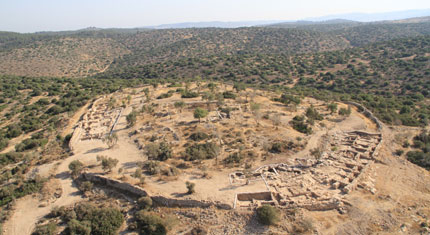Archaeological Discoveries: 3,000 year-old Israelite Shrines Discovered Outside Jerusalem
(May 2012)
Excavators at Khirbet Qeiyafa, a fortified city 30 kilometers southwest of Jerusalem in the valley of Elah that served as a border city for the Kingdom of Judah, unearthed three biblical-era shrines. The landmark discovery included pottery, stone and metal tools, and art and cult objects that together shed light on the culture and times of biblical kings in what is today the State of Israel.
The discovery is extraordinary because it is the first time that shrines from this time period have been found. The shrines pre-date the construction of King Solomon’s temple in Jerusalem by 30 to 40 years; provide the first physical evidence of a cult in the time of David; and thus have significant implications for the fields of archeology, history, and biblical and religious studies.
The recent discovery is the result of six-week excavations for the last five summers at Khirbet Qeiyafa, which sat opposite the Philistine city of Gath and existed for a short time period between circa 1020 and 980 B.C.E., after which it was violently destroyed.
While it is well-known that the people of Israel conducted what archeologists call a “cult” different from all other nations of the ancient Near East in that they were monotheistic and banned human and animal figures, it is not clear when exactly these practices were formed and solidified; if during the monarchic times (10th-6th centuries BCE) or later, in the Persian or Hellenic periods.
The absence of human or animal images in the objects and shrines discovered at Khirbet Qeiyafa serve as further evidence that the Israelites practiced a different cult from the Canaanites or Philistines in their banning of images of animals or people. Additionally, the absence of pork images suggests that the Israelites did not eat or interact with pigs. The discovery also indicates the existence of phenomena such as state formation, establishment of an elite social class and urbanism as early as King David’s time.
The shrines themselves were part of larger building complexes, as is written in Samuel [2:6]: “He brought the ark of G-d from a private house in Kyriat Yearim and put it in Jerusalem in a private house.” The shrines are thought to be some of those private houses.
The objects include five standing stones (massebot), two basalt altars, two pottery libation vessels, and two portable shrines, one made of pottery (20 centimeters high) and the other of stone (35 centimeters high). The clay shrine has an elaborate façade, including two guardian lions, two pillars, a main door, rooftop beams, folded textile, and three birds on the roof. Two of these elements, the pillars (Yachin and Boaz) and the textile (Parochet) are described in Solomon’s Temple.
The stone shrine is made of soft limestone painted red; its façade decorated by seven groups of roof-beams – the “triglyph,” like in classical Greek temples such as the one at the Athenian Parthenon – and the recessed door. These roof beams are the earliest known example carved in stone, which is another reason this discovery is a landmark is world architecture.
The stone model helps make sense of the description of Solomon’s palace in Kings I [7:1-6] where the text uses the term slaot and sequfim, both of which were previously misunderstood but have been cleared up to mean triglyphs and triple recessed doorway, respectively. In this way, new archaeological discoveries like the one at Khirbet Qeiyafa help clarify the meaning behind often-cryptic biblical text.
Sources: Israel Ministry of Foreign Affairs, “Cultic shrines from time of King David,” MFA, May 8, 2012.


